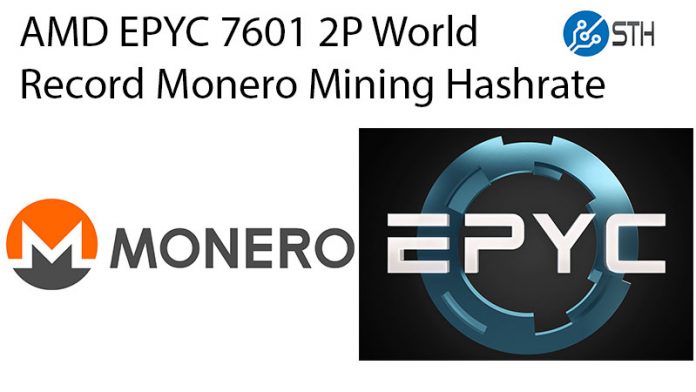Today we have some exciting results to share. The AMD EPYC 7601 dual processor system we have in the lab has set a world record for dual socket Monero mining, by an enormous margin. While we are not going to call this an official number since it is using pre-production firmware and we did essentially zero optimization, the performance is stellar.
Wait, Why Monero Mining?

At STH, we pioneered using off-peak processing capacity to offset operational costs. Our Docker-based mining images are deployed on large swarms. The case is simple, utilize wasted resources to offset data center operational costs. To this end, our most popular public and free Docker Monero mining image has over 100,000 pulls on Docker Hub (despite the fact we recommend using many of our others.)
Monero is one of the few cryptocurrencies that is both large (top 10 cryptocurrency market cap) and can be efficiently mined on general purpose x86 CPUs. As such we have started helping others to push Monero mining on their servers to utilize off-peak data center capacity to mine Monero.
Over the last few months, we have seen this pushed over 10’s of thousands of servers in data centers. We have also done pieces on mining efficiency both using Intel Xeon CPUs as well as AMD Ryzen CPUs.
Setting a New 2P World Record Using AMD EPYC 7601 with Monero
Even using pre-production firmware where we have been asked not to provide formal benchmarks, we wanted to show Monero mining performance as it is significantly better than anything we have seen in two sockets previously. Here is the video:
For those who cannot watch, this is 3.5KH/s performance using 100% of resources. Breakeven even on expensive Northern California data center power occurs around 40% of time spent Monero mining. This is transformational as it can change the ROI of colocation versus cloud operations if the cost of housing the server can be offset using 40% downtime roughly equivalent to nights and weekends.





I’m going to send you an e-mail. I’d love help bringing this to our cluster. We only have around 3000 dual socket Xeons now but we expect to grow.
Maybe Epyc-mix?
Great. Happy to help you.
Will be interesting to see how much of a difference the production firmware makes when you receive it.
And I would also be interested in how stable the system is on massive parallel loads, there have been reports of problems with Ryzen, for example in parallel gcc/make jobs (sig 11).
any idea on the server cost for a duel version cant seem to find any vendors for this CPU
Is this a realistic solution for someone who wants to mine monero at home? What’s the costs of having a setup like this with the AMD epyc Cpu’s? $12,000+?
Not advisable to purchase for the purpose of mining. But if you have one, you can consume excess power in a data center and do well.
If you want to purchase systems to mine, the Ryzen 5/ 7 chips are better values.
Hi Pat, with the benefit of hindsight, which motherboard would you recommend if you were to build an Epyc dual CPU SP3 socket workstation today? Would it be Gigabyte, Super Micro, or AsRock Rack, or others? Ideally, it should fit into an easily accessible chassis.
It’ll primarily be used for everyday computing workstation, but I’d like to use downtime to mine. Thank you for taking time to advise.